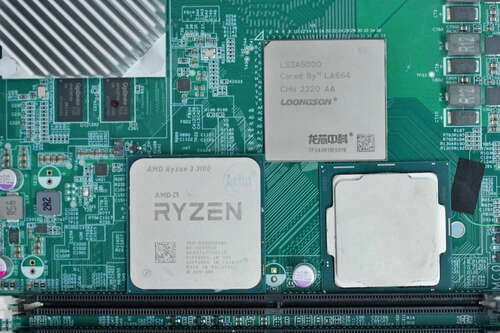A hot potato: China is willing to fight US restrictions on advanced technology with domestically-produced chip products, and the highly-discussed Loongson CPU line is receiving further confirmation regarding its presumed capabilities when compared to traditional x86 microchips.
A few months after unveiling the 3A6000 CPU, Loongson is now enjoying new reviews that seemingly vouch for the processor’s prowess and performance levels. Chinese site MyDrivers took the Loongson 3A6000 CPU for a spin, confirming that the chip can achieve “comparable” performance to a three-year-old Intel Core CPU.
MyDrivers tested the 3A6000 model in synthetic benchmarks and found that the chip provides 60 percent more performance in single-core tasks and an impressive 2x performance uplift for multi-core tasks compared to the 3A5000. The Loongson 3A6000 is a quad-core CPU and appears to be more efficient than the previous generation, with true multi-threading support.
The Loongson 3A6000 is based on the new LoongArch architecture, a poorly documented ISA mostly derived from the RISC-based MIPS architecture. MIPS was developed in the US, where it has now been retired in favor of RISC-V. However, Loongson continued to improve the architecture after obtaining official licenses for the MIPS32 and MIPS64 ISAs in 2011. The LoongArch’s design supposedly includes elements from both MIPS and RISC-V.

In August, Loongson stated that its newly developed chip was able to achieve performance levels comparable to Intel’s 10th-gen Core CPUs released in 2020. Tests conducted by MyDrivers appear to confirm the company’s official statements, as the 3A6000 chip was only five percent slower than the i3-10100F and between 10 percent and 15 percent slower than the Ryzen 3 3100 in single-thread and multi-thread workloads.
MyDrivers conducted additional benchmarks as well. In UnixBench, the 3A6000 was two percent slower than the i3-10100F and eight percent slower than the Ryzen 3 3100 in single-core tests, while it was eight percent and 11 percent slower in multi-core loads. If these results prove to be accurate, it confirms that the Loongson CPU technology is indeed evolving and improving much faster than anticipated.
While the Loongson 3A6000 quad-core chip may not yet outperform Comet Lake and Zen 3 CPUs in terms of performance, Loongson appears to be on the right path for success. This is especially true if Beijing’s engineers can achieve significantly higher clock rates from the LoongArch architecture, as the 3A6000 chip currently runs at a maximum of 2.5 GHz.

